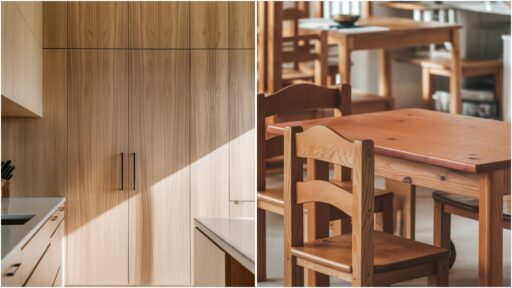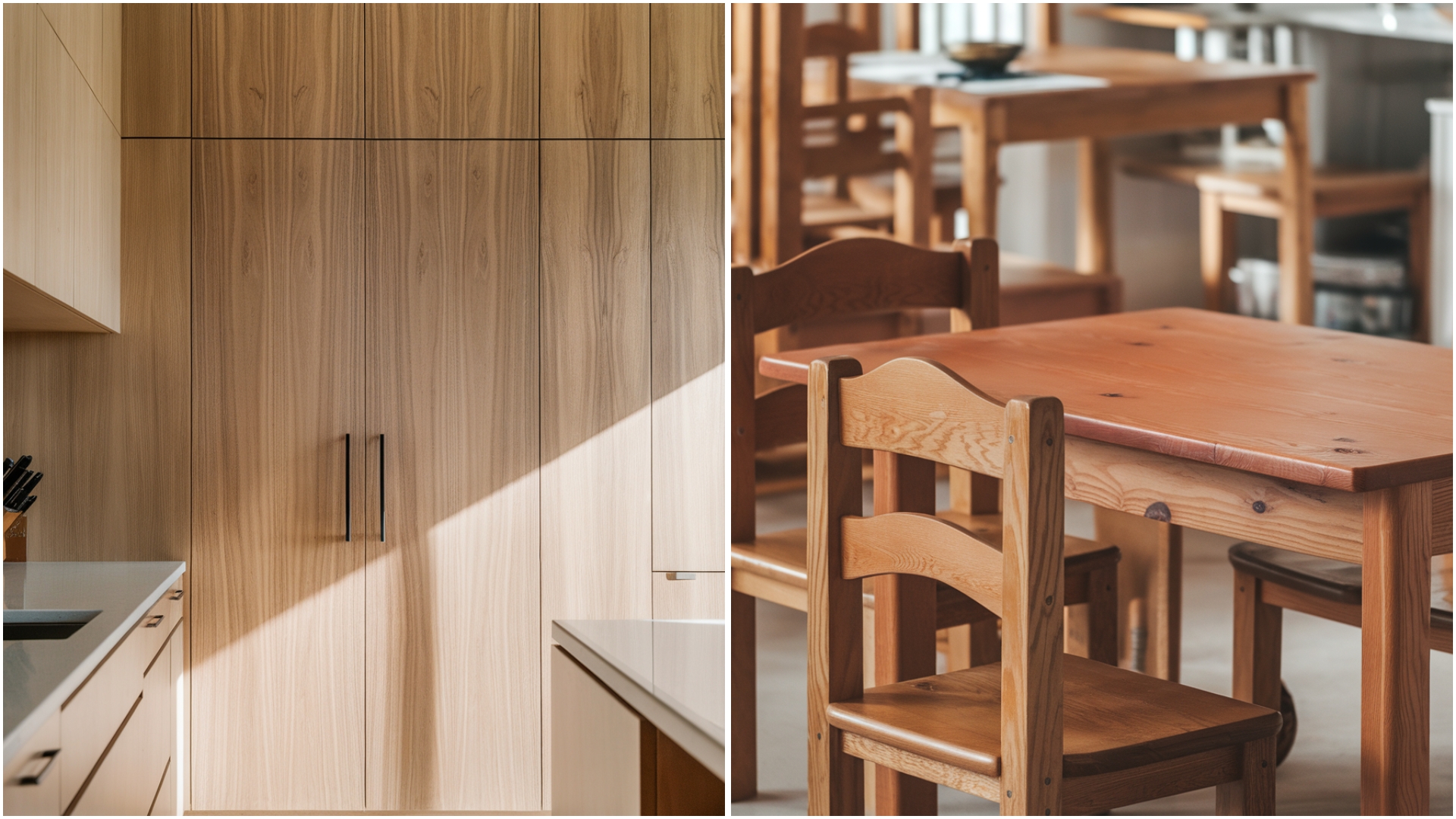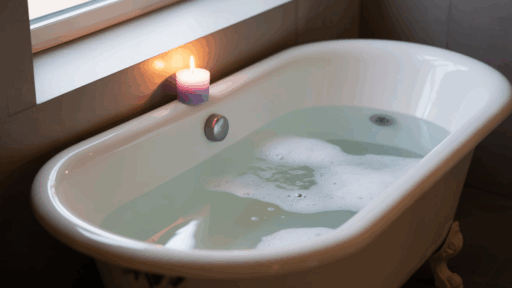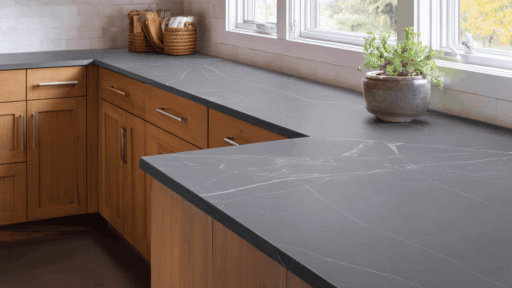Choosing the right wood can be overwhelming, especially when choosing between white oak and red oak.
These two popular hardwoods might seem similar at first glance, but they have important differences that can make or break your woodworking project.
From color and grain patterns to durability and cost, understanding what sets these oak types apart will help you make the perfect choice.
If you’re planning new flooring, building furniture, or creating custom cabinets, knowing the unique characteristics of each wood ensures your project looks great and lasts for years.
Let’s find out everything you need to know about these amazing hardwoods.
Overview of Oak Wood
Oak wood stands as one of the most beloved and widely used hardwoods in the world.
Known for its incredible strength, durability, and beautiful grain patterns, oak has been a favorite choice for builders and craftsmen for centuries.
This adaptable wood resists wear and tear exceptionally well, making it perfect for high-traffic areas and heavy-use items.
Oak’s natural beauty and reliability have made it a top choice for furniture makers, flooring installers, and cabinet builders who want materials that will last for generations.
While there are many oak species, two main types dominate the market: red oak and white oak. Each type offers unique characteristics and benefits, making them suitable for different projects and preferences.
Color Differences
One of the easiest ways to tell red oak and white oak apart is by looking at their natural colors.
These color differences remain visible even after the wood is finished, although stains and finishes can alter their visibility. Understanding these color traits helps you pick the right oak for your project.
White Oak’s Light Brown to Beige-Gray Tones
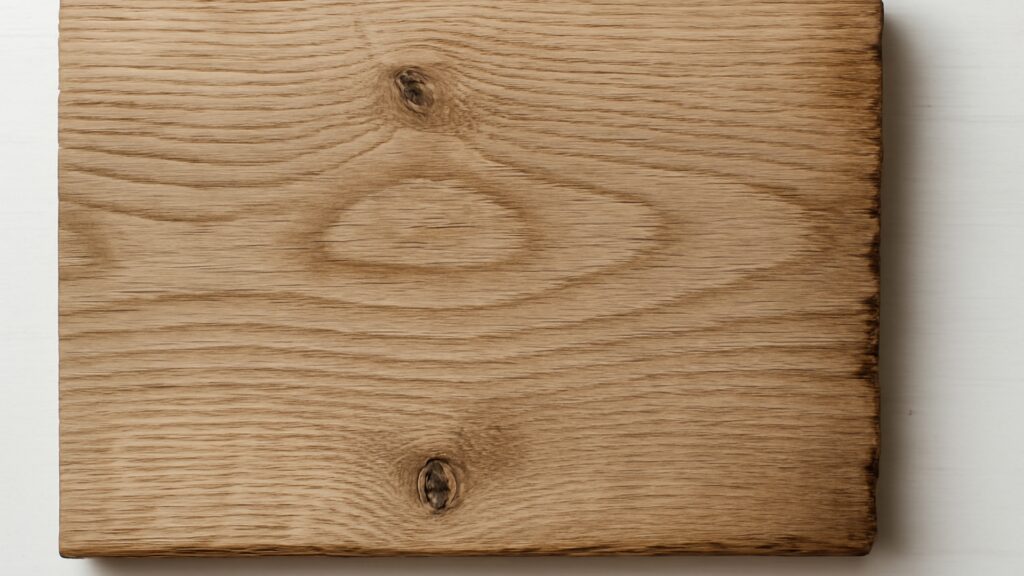
White oak has cooler, more neutral colors ranging from light brown to beige-gray. Unlike red oak, it lacks warm pink or red tones, giving it a cleaner, more subdued appearance. In natural light, white oak shows its actual grayish-brown color clearly.
Under artificial lighting, it may appear slightly warmer but still maintains its neutral character. Light stains highlight its natural pale tones, while darker stains create rich, even colors.
Red Oak’s Pinkish-Reddish Hue
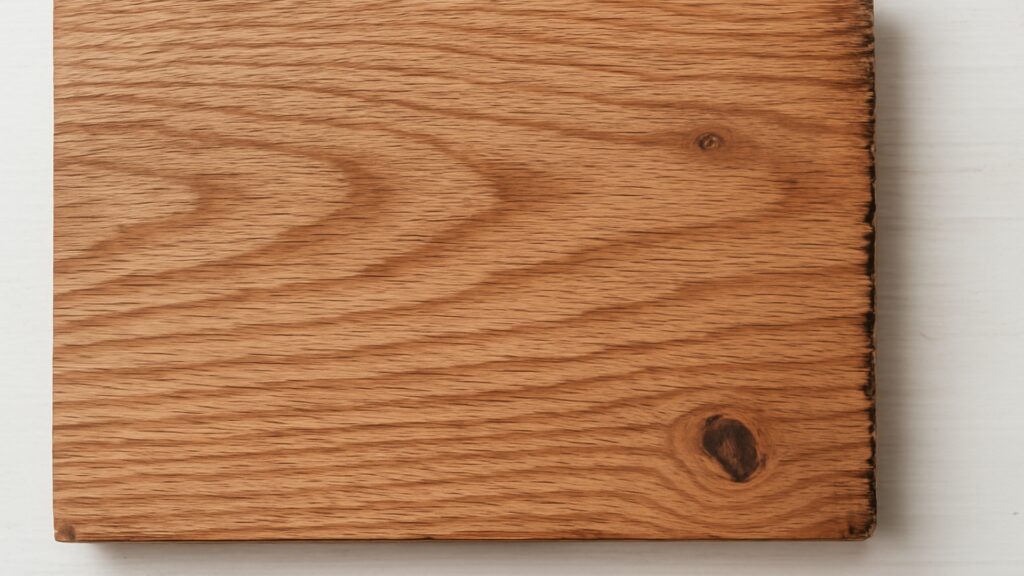
Red oak gets its name from its warm, pinkish-red color that shows throughout the wood. This reddish tint is most obvious in bright, natural light and on unfinished wood. Even with clear finishes, you can still see the pink undertones.
In dim lighting, red oak may look more brown, but the warm, rosy hints remain. When stained with darker colors, the red tones become less noticeable but don’t completely disappear.
Oak Wood Grain Patterns
The grain pattern is a key difference between red and white oak. Red oak has an open, dramatic grain structure, while white oak features a tighter, more uniform pattern.
These differences make each type suited for different design styles.
| ASPECT | RED OAK | WHITE OAK |
|---|---|---|
| Grain Structure | Open, porous with visible pores | Tight, dense with smaller pores |
| Pattern | Bold swirls and cathedral patterns | Straight, uniform lines |
| Visual Impact | Dramatic, busy appearance | Subtle, clean look |
| Texture | Rougher due to open grain | Smoother, refined |
| Best Styles | Rustic, farmhouse, traditional | Modern, contemporary, minimalist |
| Staining | Absorbs unevenly | Takes stain evenly |
Red oak’s bold grain creates striking patterns perfect for rustic or traditional settings where wood is a focal point. White oak’s refined grain provides versatility for modern spaces that require a cleaner, more subtle appearance.
Performance and Practical Use
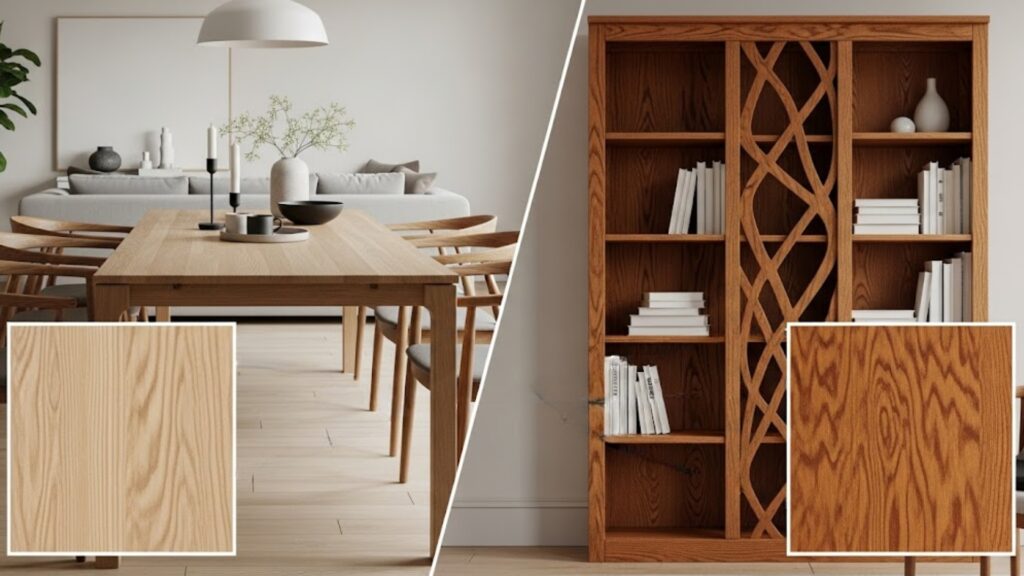
When choosing between red oak and white oak, understanding their performance differences is crucial. Both types are strong and durable, but they have distinct advantages that make them better for certain projects.
1. Durability Comparison
White oak is denser and naturally more water-resistant than red oak, making it ideal for outdoor projects and high-moisture areas, such as bathrooms. Its tight grain structure helps block water from soaking in, preventing rot and decay.
Red oak is slightly softer and more porous, allowing water to penetrate more easily. However, red oak still offers excellent durability for indoor furniture, cabinets, and flooring where moisture isn’t a major concern.
2. Janka Hardness Rating
Red oak scores 1,290 on the Janka hardness scale, while white oak rates slightly higher at 1,360. This difference means white oak resists dents and scratches better, making it ideal for high-traffic flooring areas. Both woods are considered hard enough for most furniture and flooring projects.
The higher rating of white oak translates to better long-term performance in demanding applications, though both types handle everyday use very well.
3. Workability and Finishing
Red oak is generally easier to cut, drill, and shape because of its open grain structure. However, this same open grain can cause uneven stain absorption, creating blotchy finishes. White oak requires sharper tools and more careful handling due to its density.
But it rewards you with smooth, even stain coverage. Both woods glue well and hold screws securely, making them excellent choices for furniture making and construction projects.
4. Cost and Availability
Understanding the cost and availability differences between red oak and white oak helps you plan your project budget and timeline. These factors vary based on location, demand, and specific applications.
| FACTOR | RED OAK | WHITE OAK |
|---|---|---|
| Cost | $4-6 per board foot, budget-friendly | $7-9.95 per board foot, premium pricing |
| Availability | Widely available, common stock | Less common, may require ordering |
| Supply | Abundant in eastern North America | More limited natural distribution |
| Lead Time | Usually in stock, immediate | May require 1-2 weeks for ordering |
| Export Demand | Readily available worldwide | Higher international demand |
Red oak’s lower cost and wide availability make it the go-to choice for budget-conscious projects, while white oak commands premium prices due to higher demand and limited supply.
5. Best Applications
Red oak excels in interior projects like furniture, kitchen cabinets, trim work, and budget-friendly flooring, where its warm color and bold grain add character.
It’s perfect for traditional and rustic designs. White oak shines in high-end flooring, outdoor furniture, boat building, and wine barrels, where its moisture resistance is essential. Its neutral color and refined grain also make it ideal for modern and contemporary designs requiring a clean, refined look.
Quick Identification: Red Oak vs White Oak
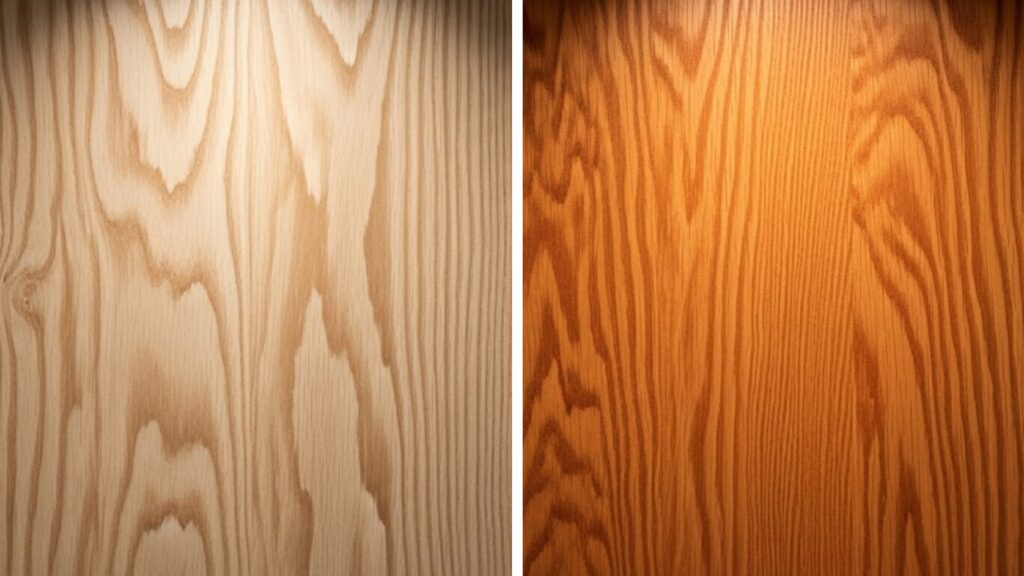
Telling red oak and white oak apart can be tricky, but there are several simple ways to identify each type.
By checking a few key features, you can quickly determine which oak you’re looking at, if you’re shopping for lumber or examining existing woodwork.
- Color: Red oak has warm pinkish-red tones, while white oak shows cool beige-gray colors.
- Grain pattern: Red oak exhibits bold, open grain with cathedral patterns, while white oak features straight, tight grain lines.
- End grain pores: Red oak pores are large and easily visible; white oak pores are small and filled with tyloses.
- Weight: White oak feels noticeably heavier and denser than red oak pieces of the same size.
- Smell: Red oak has a mild, slightly acidic scent; white oak smells more neutral (optional test).
Using these simple tests, you can confidently identify oak types for your next woodworking project. The most reliable method is checking the end grain pores with a magnifying glass, as this difference never changes regardless of staining or finishing.
Which Should You Choose?

Choosing between red oak and white oak depends on several important factors.
Consider where you’ll use the wood first; white oak works better outdoors and in wet areas like bathrooms, while red oak excels indoors.
Think about your style preferences too: red oak’s warm, bold grain suits traditional and rustic designs, whereas white oak’s clean, neutral look fits modern spaces perfectly.
Budget matters as well, since red oak typically costs less than white oak. For high-traffic areas like floors, white oak’s extra hardness provides better durability.
Red oak offers easier workability and striking grain patterns, ideal for furniture and cabinets. White oak offers better moisture resistance and a refined appearance, but it is more challenging to work with and more expensive.
Final Thoughts
Now you have all the essential information to confidently choose in the white oak vs red oak debate.
Red oak offers budget-friendly beauty. Its warm colors and bold grain patterns make it perfect for traditional indoor projects. White oak provides superior durability and moisture resistance.
Its refined appearance is ideal for high-end flooring and outdoor applications.
Consider your project location, style preferences, budget, and expected wear when making your final decision. Both woods offer exceptional quality and classic appeal, so you really can’t go wrong.
Choose the oak that best suits your needs and create something beautiful that lasts for generations.
Find more smart solutions in our home improvement section for every corner of your home!

